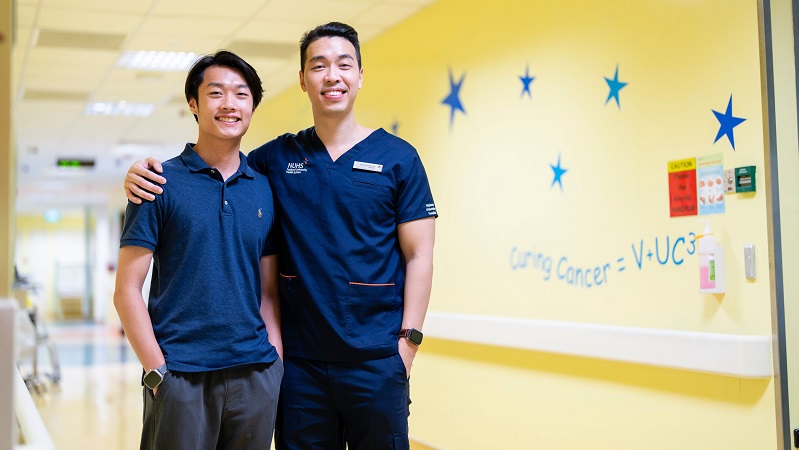Amidst the fight against paediatric acute lymphoblastic leukaemia, a study signals a shift from indiscriminate drug regimens to precision medicine, marking a crucial stride towards more targeted and patient-friendly treatments
Issue 1 | June 2023

 Subscribe and ensure you don't miss the next issue!
Subscribe and ensure you don't miss the next issue!
Acute lymphoblastic leukaemia (ALL) is the most common paediatric cancer in Singapore, representing approximately 35% of cancer cases in children. With almost half a million new diagnoses worldwide in 2020, ALL is a type of blood cancer marked by the overproduction of immature white blood cells, or lymphoblasts, in the bone marrow. These abnormal lymphocytes overwhelm their normal counterparts, compromising a patient's immunity.
But as doctors and researchers navigate the challenging terrain of treating ALL, they encounter a revealing complexity: the disease is far from monolithic. It encompasses a multitude of distinct subtypes, each with its own unique characteristics and prognosis.
For decades, the treatment strategy for ALL has remained somewhat uniform, with a cocktail of 10 to 12 different chemotherapy drugs administered to young patients, regardless of their disease's subtype. This one-size-fits-all approach, while effective in many instances, often brings an onslaught of side effects, from heart damage and limb paralysis to the abnormal growth of bone or muscle, some of which follow the survivors throughout their lives.
Unveiling a new era in medicine
Today, however, a paradigm shift is on the horizon, heralded by a pioneering study led by Dr Shawn Lee, consultant in the Division of Paediatric Haematology and Oncology, Department of Paediatrics, Khoo Teck Puat - National University Children's Medical Institute (KTP-NUCMI)1 at the National University Hospital (NUH). This international collaboration between NUH and US institutions such as St. Jude Children's Research Hospital in Memphis, Tennessee and Johns Hopkins University in Baltimore, Maryland embarked on one of the first missions to map out the intricate genetic landscape of leukaemia, sifting through the disease's myriad subtypes to identify how well each of them responds to chemotherapy.
The study evaluated the leukaemia cells from 800 children aged six months to 18 years in the US. Instead of the traditional, uniform treatment strategy, the study has shed light on a precision medicine approach, tailored to the genetic quirks of each subtype. The study's results were published in the journal Nature Medicine.
"The varied responses of ALL subtypes to individual chemotherapy drugs reveal a fundamental flaw in our conventional approach: treating diverse conditions with a uniform regimen," explains Dr Lee. "Our findings could potentially significantly shift the treatment landscape of ALL, making it more individualised and reducing the unnecessary side effects faced by our young patients."
One striking example of this genetic variability emerged with the finding that early T-cell precursor ALL, a specific subtype, was less responsive to vincristine and daunorubicin, two drugs commonly used to treat most ALL subtypes. Yet these same medications remained effective for many other subtypes, hinting at the complexity of ALL's genetic canvas.
Meanwhile, some drugs like dasatinib, typically used to combat Philadelphia-positive B-cell ALL, another ALL variant, demonstrated surprising effectiveness against certain T-cell ALL subtypes.
"Thanks to advances in technologies such as RNA-sequencing, we can now determine which treatment is best suited for each patient. Precision medicine efforts don't merely enhance our understanding of ALL - it offers a route to improve the quality of life for our patients by mitigating side effects once thought to be an inescapable part of the treatment journey," says Dr Lee.
Carving out a kinder therapeutic landscape
Moving forward, the research team intends to share their findings with hospitals locally and in the US and use their results to inform new ALL trials across Southeast Asia.
With precision medicine poised to transform how doctors treat ALL, hope glimmers for young patients facing this daunting diagnosis. By shifting from a broad-spectrum chemotherapy approach to a precision-guided one, Dr Lee and his colleagues at NUH are charting a course towards a world where triumphing over leukaemia will no longer demand a lifelong toll on patients.
1KTP-NUCMI is part of the National University Centre for Women and Children (NUWoC), a national university specialist centre that aims to empower women, children and their families to lead healthier lives.
Like this article? Simply subscribe to make sure you don't miss the next issue of EnvisioningHealth!




















